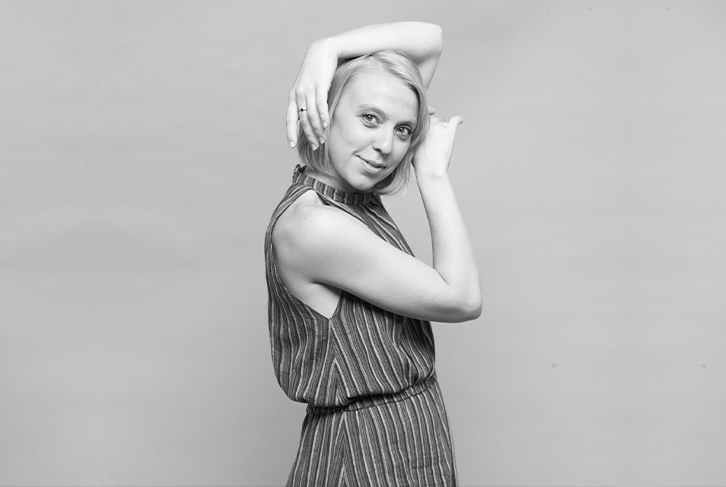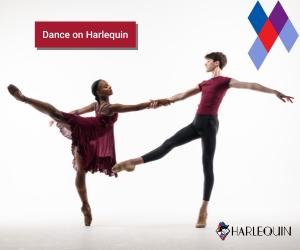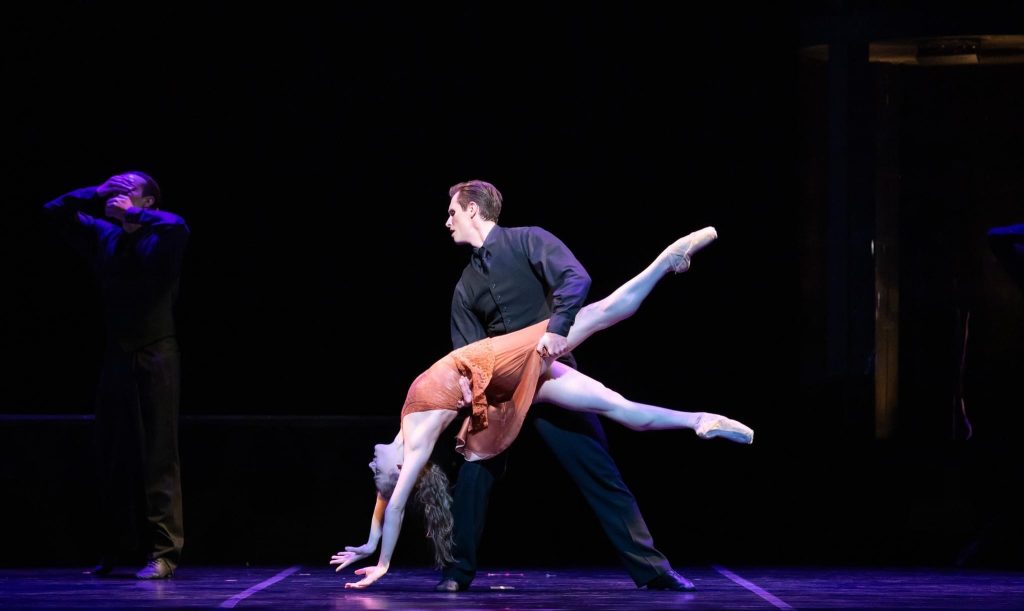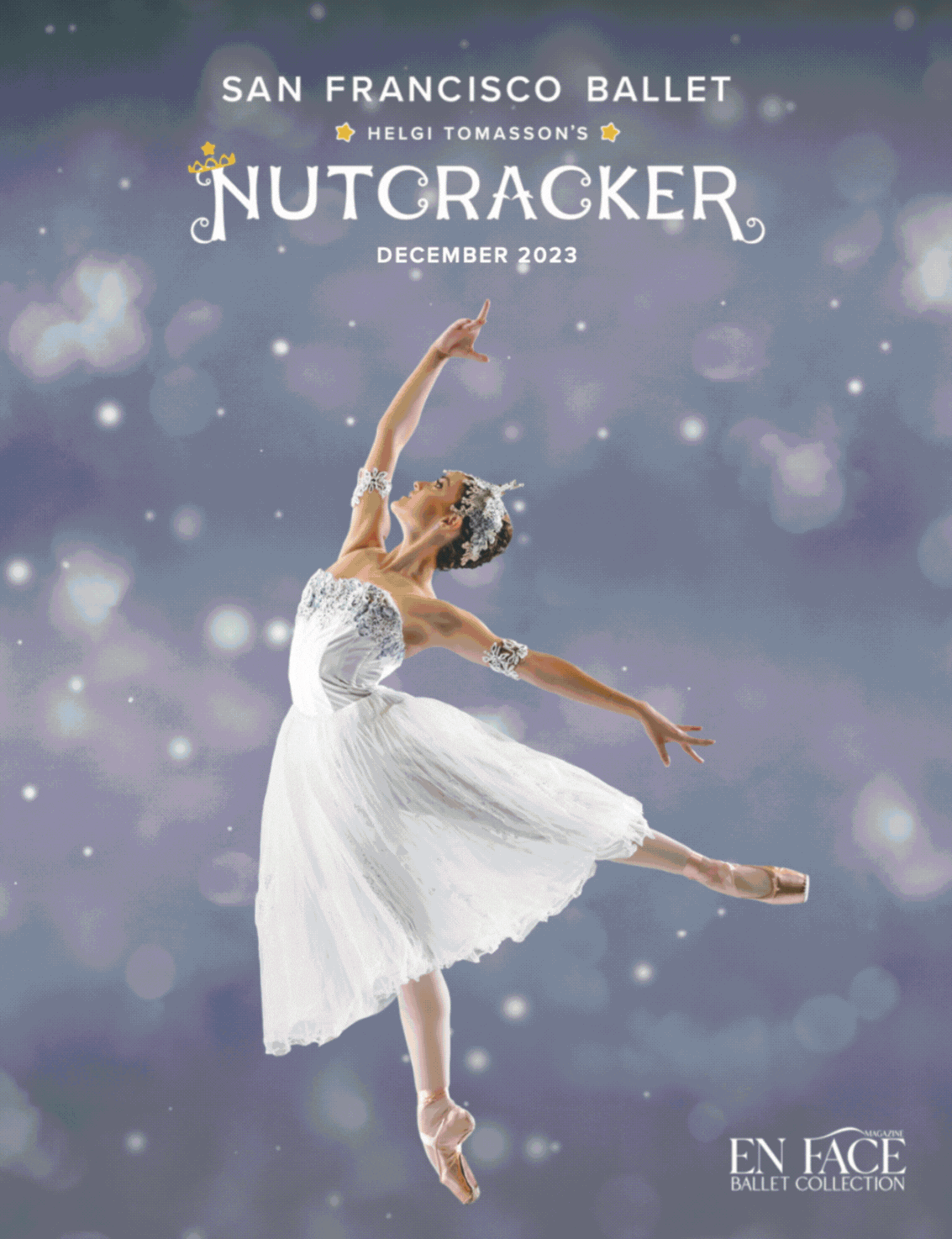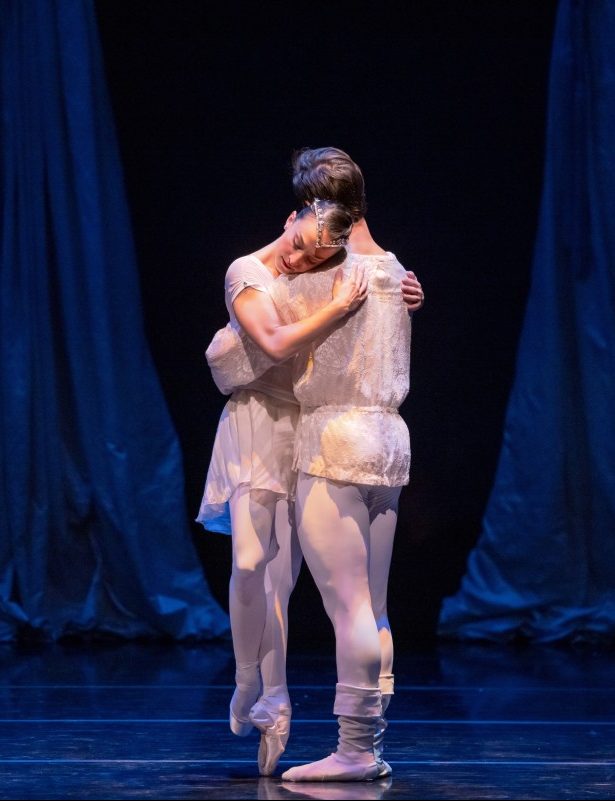
Nicole Haskins headshot by Tatiana Wills
A Peaceful Prayer from Smuin Ballet’s A Christmas Ballet,
Choreography by Nicole Haskins, Photo by Chris Hardy
For many of us, the holidays are full of traditions that we hold dear. Steaming mugs of hot chocolate sipped by the fireside, using glittering rolls of wrapping paper to ever so clumsily encase a last minute purchased gift, and of course, curling up in the seats of a cozy theater to be dazzled by The Nutcracker once again. But one tradition that hits closer to the heart than all of these, is that of coming back home. A tradition that choreographer Nicole Haskins is embodying in a uniquely balletic way this holiday season.
Nicole is a dancer and choreographer whose love of ballet and enthusiasm for choreography emerged during her training at the Westside School of Ballet in Santa Monica. From there she went on to dance professionally with Sacramento Ballet, Washington Ballet, and Smuin Contemporary American Ballet in San Francisco, retiring in 2019. Throughout her dancing career Nicole was devoted to developing her skills as a choreographer, and while she now has had commissions from all across the country, today we are exploring the works that she has built for her former dancing homes, Sacramento Ballet and Smuin Contemporary American Ballet.
Thank you so much for joining us today Nicole! Can you tell us a little about your dancer and choreographer journey that has led you here?
Absolutely! I’m a California native and I trained at the Westside School of Ballet in Santa Monica, California. They really treated us as if we were putting on professional shows, and while I was there we performed The Nutcracker every year, and I worked my way through the roles from Polichinelle to Sugar Plum. Over the years I was there I also got a lot of opportunity to choreograph.
From there I went to Sacramento Ballet where former dancers from my studio had already gone, so there was already a connection. I spent the first 7 years of my career at Sacramento Ballet. And again, I was very fortunate that not only did I get to dance a lot of really great ballets, but I also got to choreograph. They really allowed me so much freedom and they helped me gain skill and authority in my choreographic voice.
From there I went on to Washington Ballet where I was able to keep expanding my repertoire, and then I went to Smuin Ballet. While there I got to do a little more in the contemporary ballet field, which up until that point, most of my career was centered around classical ballet. And again, this company happened to have a choreographic workshop, so I was able to create pieces, and from there they could see that I had something to say and that they liked what I had to say.
While there, the Artistic Director, Celia Fushille, asked me to create pieces for the Christmas Ballet, and while that was happening I also started to get some outside commissions, and she was really incredible about allowing me time when I could go to choreograph and then come back and dance.
I was very grateful that I was able to start building this other aspect of my professional persona while I was still dancing, so that when I retired I wasn’t starting from scratch. From there I became the resident choreographer at Mid-Columbia Ballet, and then the pandemic happened. At that point I ended up starting and running the Ballet Idaho trainee program and building that for the next generation of dancers. And now I’m back in the Bay Area.
When I told Celia I was back in town, a week later she reached out and said, “Would you like to do another piece for the Christmas Ballet?”So it’s been a really special homecoming.
It sounds like it. You have now contributed choreography to both Sacramento Ballet’s Nutcracker as well as Smuin Ballet’s Christmas Ballet, becoming a key voice of holiday ballets in the Bay Area. You’ve contributed three of the pieces in this year’s Smuin’s Christmas Ballet, correct?
Yeah, I’ve choreographed a total of four pieces for the Christmas Ballet over the years and three are included in this year’s rendition. Every year it’s kind of a different arrangement of things. I did a new duet this year and then they brought back two of the pieces I made while I was a dancer with them.
It’s been a special experience because I have never seen the Christmas Ballet from the audience. I’ve always danced in the show, and while it’s really special to watch your choreography from the wings, it was just something else to be in the audience.
It was such a joy to see the pieces that I created at different points during my career. Some were from when I first joined Smuin Ballet, and others were from my last year I was a part of the company, and now there’s one from after I retired.
I was just really grateful to come back to the Bay Area. The Christmas Ballet is a fun thing to choreograph for because the show changes every year, but the format stays the same. So the first act is all classical music, a lot of choral music, and everything’s in white. And then the second act, we kind of flip that on its head and everything’s in red and there’s everything from Santa Baby to tap dancing, Christmas trees, and everything in between. So there’s like a general mood you kind of know you have to fit into.
And the dancers have a lot of dancing to do. They’ll be in maybe 18 of the 27 numbers in a particular night. So you can’t do the hardest thing you’ve ever created in your life. It’s a fun challenge in the sense that in three minutes, how can you make something different that hasn’t been in the show before that still fits within the vocabulary and the framework of what has come before?
It’s been a surreal, special experience being back in the Bay Area, going back and forth between these two places, Smuin Ballet and Sacramento Ballet. I spent so much of my professional career here and now I get to continue doing so in a different capacity, still being a part of these companies.
It really is a homecoming – this journey of the places where I’ve danced, and I’m coming back, being able to infuse fresh choreography and help raise up the next generation of dancers who are in both places. What an amazing way to be such a deep part of both companies’ legacies. It’s been really special and I couldn’t have planned it better that this is where we ended up. It’s kind of like I never left.
With the Sacramento Nutcracker, since you had danced in the prior production, can you tell me a little bit about how that experience influenced how you wanted to build the new production, and what it felt like to be creating that piece with your former coworkers and dancers?
Yes – it was so interesting. I worked alongside two other dancers (Colby Damon and Julia Feldman), one also former like myself and one current dancer from Sacramento Ballet. Last year when we were choreographing we came in ready to tackle this traditional piece and put our own spin on it.
The three of us spent a lot of time over the summer of 2021 discussing how we wanted the arc of the story to go. We all knew which sections we would be choreographing, but we really wanted it to feel like a streamlined story and not so disjointed that an audience member could look at it and say, this is clearly Julia, this is Colby, and then at the end Nicole shows up.
So that was where I think our knowledge of the previous productions helped – we knew what the sets were, we knew what the costumes were, and we kind of knew the layout of how things have gone.
We all brought our previous Nutcracker experiences together, especially those from when we were children. All three of us had such strong memories from when we were kids, almost more so than when we were professionals. It was really important to us to try to create something as special as it had been for us when we were kids for the kids that would be in this production.
The biggest change we made was in Act II. Since there have been so many discussions in the industry about the different countries and how they’re portrayed, we decided to go in an utterly different direction. We transformed it into the land of Sweet Enchantment and every divertissement is focused on a character instead of a country.
We have Cinnamon Spice and an Orchid, Sapphires, and a Gnome. This way we were allowed to retain the traditional sensibilities of these dances, but also put our own take on it and not be tied as much to the format of the countries. And I think no one really missed them. We weren’t trying to make this big statement, but instead of us trying to tow a line and have some people happy and some people upset, it felt most authentic to simply make our own version.
And I think it really came together so nicely, since it was already kind of random anyway. The biggest change for me, since I was mostly focused on Act II, was that I really wanted to make the Sugar Plum Fairy a real person. I think sometimes she’s so proper that she is inaccessible. And I remember being Clara and just looking up at this dancer in such awe – I really wanted that emotion and sense of connection to shine through. We made sure that the dancer who dances Sugar Plum in Act II plays Clara’s mother in Act I to already set up that familial relationship.
In the places where Sugar Plum felt a little reserved, I added a little more warmth and movement to what was happening. That was a really fun challenge to me, to kind of keep in the parts that if I had never danced Sugar Plum, I would be upset that I was missing out on. I wanted the dancers to do the things that they grew up seeing, while also making sure that they felt that they could really just fully lose themselves in the dancing and not feel so worried about everything being perfect. One of the ways I did that too was that typically the men always get to choreograph their own solo, and the women are kind of stuck with the solo as it is. And so I tried to really put in places for the women to decide what they wanted to make for their own materials. Every dancer is different, and in traditional classical ballet, women often have to contort themselves to fit into this one definition of what the ballerina is. And so if we’re already gonna do this fresh take on Act II, I wanted to give the women the opportunity to bring their own dance and artistic self to the performance. I wanted to give them more ownership of who they are on stage.
Those are some of the things I’m most proud of with this Nutcracker production. Last year was when it actually premiered for the first time. It was very stressful. I’ve never put on a full production before, even though we even had sets and costumes pretty much done. When it comes to the first year of everything, it’s all the little things you don’t think of. So already this year was so much better.
And last year was such a whirlwind, I don’t know if I really appreciated the gravity of what an exciting opportunity and experience it was to be a part of Sacramento Ballet’s Nutcracker. it was so rewarding to get to come back this year and know that it’s already created. I didn’t have to change things, and instead I could just appreciate what the three of us were able to create together and dive in further.
I’ve been able to give more artistry notes, detailed, instead of what last year was like – figuring out what the language of the ballet was – and now we just get to add the flourishes to the dialogue. In both experiences, I was able to be in the moment and absorb the wonderful things that were happening.
So it’s been really incredible to have these things happening. Also the schedules worked out so I could go to both the opening night of Sacramento Ballet’s Nutcracker and the opening night of the Smuin Christmas Ballet in San Francisco.
I really love that the three pieces that are in the show this year cover the arc of your choreographic journey. How does how each piece capture a chapter of your artistic life?
Oh gosh. Well, the first piece I ever made for Christmas Ballet was called Fantasia, and I made it for three couples, and it was only my second year doing the Christmas Ballet. I had joined the company just the year before, and you can see that excitement in the work – it’s very energetic and joyous. I was just excited – I wanted to give people some fun things to do. It’s very playful and includes smirking with your partner. It’s, well, kind of cheeky with some silliness.
The second piece I made was actually a finale for Act I called Joy to the World. In that I see a lot more maturity in what I created. I brought back these beautiful silk capes that were in the first piece of Act I, and with that I really tried to create an exciting celebration to end the act, and it’s really rewarding every time I see it performed. And you can tell the audience is just as excited and surprised by the ending as they were the first time it happened.
Then this most recent piece, A Peaceful Prayer, is a duet to an acapella version of a song titled A Prayer for Ukraine. It’s very different than the other ones in that it’s much more somber and introspective, which I was a little worried about since it’s Christmas. It’s a holiday show, like, we all wanna be happy. But I honestly am really proud of it because it still feels very hopeful and it provides such a nice contrast to everything else that’s happening. I think the audience is really on board for the ride of the duet.
I am proud that I was able to give the dancers something more connective and mature. The Christmas Ballet is a lot of fun and full of performing to the audience, especially in Act II. And I wanted to make something a little more, well, almost vulnerable in a way that they really just have to bear themselves and simply be themselves on stage and not be a character.
I am just so proud of all of them for going on that journey with me, and even more so that each couple really found their own voice within the material. It really resonates with the audience because it doesn’t feel like they’re just putting a smile on their face. There’s more to it. We get to witness an intimate moment between two people.
It’s really nice that every time I choreograph I get to find a different side of myself and my choreography.
Just a general question, how would you describe your choreographic style?
Oh gosh, that is a question. Well, I would start with that I love ballet even when I try to do the most contemporary thing. I like ballet. I like a pointed foot. I think ballet’s beautiful. But what I really try to do is bring the humanity to ballet. It’s in the transitions and the connections of movement that I really try to make it feel, well, I don’t wanna say authentic, but the way in which contemporary dancers have grown and how it flows naturally in the body and there’s not as much of a need for the exact destination. It’s like the feeling of something. And so I try to infuse that within ballet so that how we get into the position feels more natural and less affected. Especially with my partnering – there’s a lot of push and pull between the two partners together. I try not to make it like the man is leading and the woman is displayed, but that they work in tandem to get to the next position. I have to work with both people so that the woman has to take authority and lead, and then the man also has to allow himself to be led. To me that always creates a more authentic kind of movement between two people and it can keep things spontaneous between the two of them.
And then just when dancers are dancing by themselves, I am a big fan of people really being able to let go and be a hundred percent themselves within their movement. I strive when I’m working with dancers to listen to where their body wants to take the movement and allow them to fully realize that destination. It has taken me a long time to not want the movement to just be what I imagined in my head, but I have found that when I let dancers kind of lead the direction, it always works better because that’s how their body wants to move and if you allow them to do what their body wants to do, you always get the best result. So I don’t think I have one particular style I would say – I just really try to go in to create authentic movement within the ballet framework.
That’s fantastic. I love the emphasis on ballet technique, while adding the humanity that much of contemporary work aims to capture, merging those two together into a lovely whole.
From Sacramento to Smuin you are leaving quite a holiday stamp on the ballet community! What does that feel like?
I hadn’t even put two and two together, until you said something! I just feel very grateful that I still get to be a part of these companies that I danced with. I never really sought out to be a choreographer. I just liked putting steps to music and people kept giving me the opportunity to do so.
So it’s really humbling in retrospect knowing that what I just enjoyed doing for my own fun and to challenge myself has taken me to this place where my work is in both of these places for a holiday performance that happens every year.
It’s been so nice now that we’re back in theaters and people can come together. And I just love the holidays. I, like so many dancers, especially love The Nutcracker. It’s what we remember seeing as a kid. I’m such a nerd for The Nutcracker! And the Christmas Ballet is such a great complimentary show to that because it’s so different and yet so enjoyable and perfect for the family as well.
They both are such strong traditions in the communities where they perform that. It’s really wonderful to get to be a small part of that. From the holiday tradition of The Nutcracker to the contemporary holiday celebration and joy of the Christmas Ballet.
You mentioned that you’ve loved the Nutcracker since you were little. Can you tell me one of your earliest Nutcracker memories?
More than any role, I think it’s all about being backstage. It’s doing your makeup, it’s watching the dancers. One of the most special things for me being at a school that did the same Nutcracker every year is when we were the little Polichinelles, and we were also learning these parts that we wouldn’t do for another 10 years, but we were so excited and there’s something so special about seeing your history within a production. So when I was Sugar Plum my senior year, there’s Clara, which I did when I was 12, and there’s the Mouse that I did… I could look around and remember that I had done almost every part in that production.
As a student, there’s nothing quite like that. As a professional, you usually start out as a Flower and then you still can build, and there’s still that excitement. But for me, there’s something magical in seeing the joy and the hope and the wonder in these little kids’ eyes and realizing that that was you at some point and that you looked up to these older kids and now you’re like, I don’t feel like this older kid, but like somehow you’ve become that role model.
But The Nutcracker just… I think that’s why I always tell older dancers when they’re doing things that it’s not about it being perfect. It’s about that little girl or that little boy in the audience who’s so enraptured. This might be the moment that they remember that they wanted to be a dancer, the moment they realized that they want to be a part of it, and you get to create that for them.
That’s the most special thing to me about The Nutcracker.
And if that’s not holiday magic, I don’t know what is.
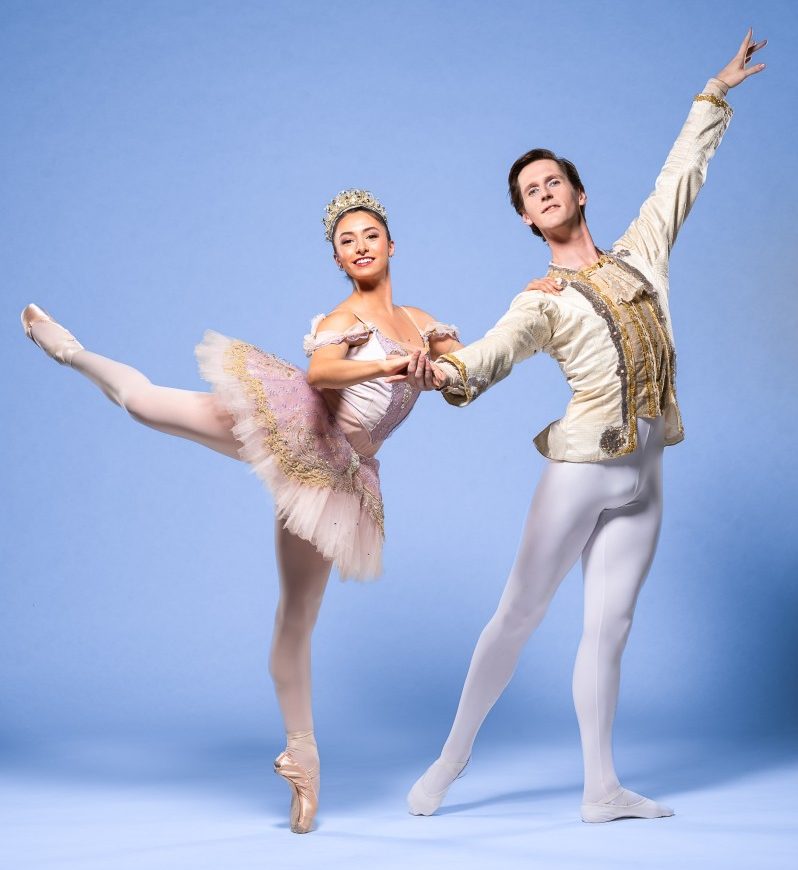
Nutcracker grand pas from Sacramento Ballet’s Nutcracker.
With Isabella Velasquez and Dylan Keane. Photography by Tony Nguyen.
Choreography by Nicole Haskins. Image courtesy of Sacramento Ballet.
Both of these holiday ballets are running through December 24th and tickets are still available, so purchase below and get caught up in the holiday spirit and the delight of homecomings!
Purchase Tickets to Sacramento Ballet’s Nutcracker

